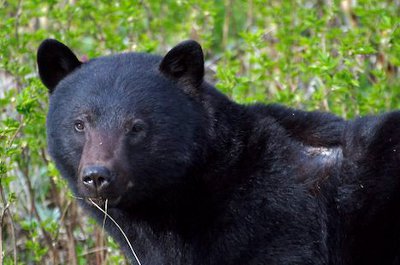Black Bear
Category: Bear

Facts about Black Bear "Scientific name for Black Bear is Ursus americanus". Black Bear is an Ursus type of bear that comes from the Ursidae family. The Black Bear are native to North America, and they are the smallest and the most extensively spread bear varieties on the continent. The Black Bear usually inhabit largely in forested regions, but they will leave the forests, looking for food. Sometimes they turn out to be fascinated to human communities, owing to the instant accessibility of food. The Black Bear is the most widespread bear varieties in the world. The Black Bear variety is one among the two of the eight modern bear varieties not considered globally endangered. The Black Bear habitually mark trees using their claws and teeth as a mode of communication with each other, a behavior that is common among several varieties of bears.
Features of Black Bear
Black bears are average-sized bears, with a body length, ranging from 4 feet to 7 feet (1.21 to 2.13 meters), measured from snout to tail, and 2 feet to 3 feet (.60 to .91 meters) height at the withers when fully grown. Usually, male Black Bear are bigger than the females. The eyes of Black bears are small, and they have rounded ears, an elongated nose, big non-retractable claws, a small tail, and bushy hair. Nearly all black bears have a true black color body, unlike black bears seen in western states that can appear with shades of brown red or blond.
According to the time of year, adult male black bears weigh between 130 pounds and 500 (58.9 to 226.8 kg), whereas the females weigh between 90 pounds and 250 pounds (40.8 to 113.4 kg). The heaviest known male wild black bear was weighed 880 pounds (400 kg) from North Carolina, whereas the heaviest known female bear weighed 520 pounds (235.8 kg) from the northeastern part of Minnesota.
Black bears are extremely adaptable, and occupy a bigger range of homes than any type of bear in the world. The home of these bears must have access to water, food, cover, and denning. Even though black bears are considered to be mature forest varieties, they habitually use a diversity of habitat types. Generally, these bears are solitary, but sows will look after the cubs. Mature bears may be found together during the breeding period and rarely yearling siblings will stay together for some period of time. They may also get together at places with plentiful food resources. Trees provide a comfortable spot for napping or a sfe haven when threatened.
Diet of Black Bear
Black bears are omnivorous and they have an extremely different diet. They feed on herbaceous plant parts, forested plant parts, flower, nectar, or pollen, fruit, young and small animals, terrestrial insects, young and mature amphibians, and carrion. The Black Bear are opportunistic feeders, feeding mostly on plants in the spring, insects and berries in the summer, and berries and nuts in the fall.
Breeding of Black Bear
Usually, female Black Bear mature when they attain the age of three years. Breeding takes place from the middle part of June to middle part of July, but in the eastern part of the deciduous forest, mating period can extend up to August. Usually, female Black Bear breed once in two years and cubs are born during early January to middle-February with a weight between 0.5 pounds and 0.75 pounds (.22 to .34 kg). The female Black Bear offers birth to a maximum of 4 cubs that are brought up by the mother bear for 1 years.
The average lifespan of the Black Bear breed ranges from 26 years to 30 years.

 Back To Category Bear
Back To Category Bear